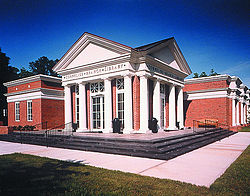Cornelius, North Carolina | |
|---|---|
Town | |
 The Cornelius branch of the Public Library of Charlotte and Mecklenburg County | |
| Nickname: Corn Town | |
 Location in North Carolina | |
| Coordinates: 35°28′21″N80°52′53″W / 35.47250°N 80.88139°W | |
| Country | United States |
| State | North Carolina |
| County | Mecklenburg |
| Founded | 1893 |
| Incorporated | 1905 |
| Named after | Joe B. Cornelius [1] |
| Government | |
| • Mayor | Woodrow Washam[ citation needed ] |
| • Chief of Police | David Baucom[ citation needed ] |
| Area | |
• Total | 13.12 sq mi (33.98 km2) |
| • Land | 12.66 sq mi (32.78 km2) |
| • Water | 0.46 sq mi (1.20 km2) |
| Elevation | 742 ft (226 m) |
| Population | |
• Total | 31,412 |
| • Density | 2,481.8/sq mi (958.23/km2) |
| Time zone | UTC−5 (Eastern (EST)) |
| • Summer (DST) | UTC−4 (EDT) |
| ZIP Codes |
|
| Area code | 704 |
| FIPS code | 37-14700 [5] |
| GNIS feature ID | 2406314 [3] |
| Website | www |
Cornelius is a suburban town located along Lake Norman in northern Mecklenburg County, North Carolina, United States. It is a major suburb of Charlotte and part of its metropolitan area. The population was 31,412 at the 2020 census, [4] up from 24,866 in 2010.


